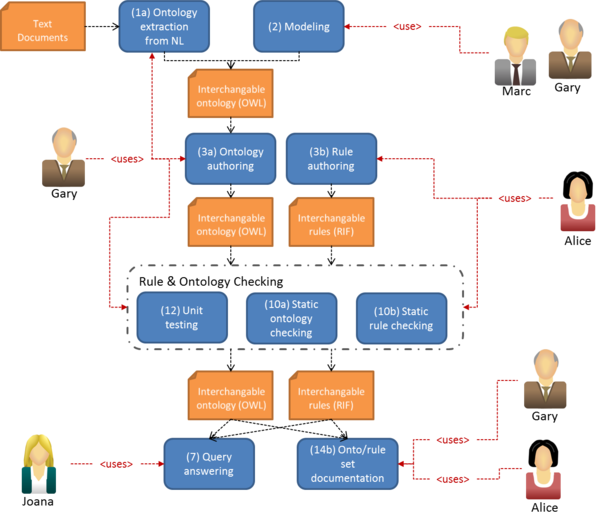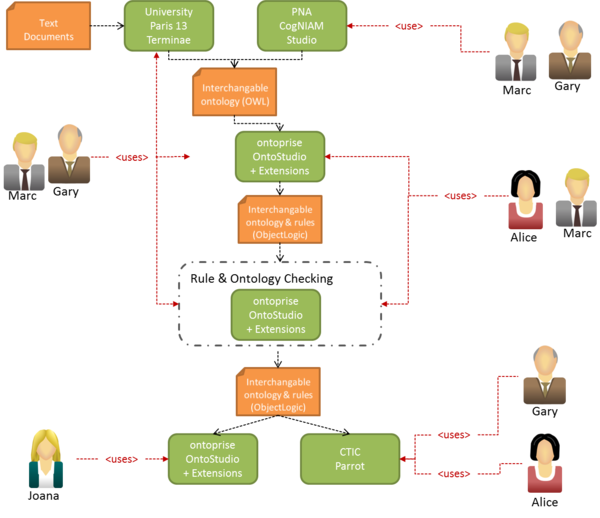From ONTORULE Show Case
Overview
|
In the automotive sector, a significant part of knowledge originates from documents such as regulations, laws or internal documents. This semi-structured knowledge can be structured into formal models (ontologies and rules) by linking ontology instances and relations to their source documents. This way, the owners of the knowledge, Business Experts, can verify the properness of the modelled semantic relations and the used linguistic terms of the various entities. Combination of the various virtual and physical CAx methods requires different costs and different time spans to produce miscellaneous qualities. Engineering Project Managers need this information when planning their projects. They need to find processes that are cheaper, faster and offer higher quality. The anticipated reduction of development costs is caused mainly by finding virtual replacements for physical analysis chains, which are less time-consuming and require less material. The different process steps are linked to IT tools. These tools help IT Managers in planning and illustrating the enterprise’s IT architecture by visualizing the workflow.
The AUDI R&D Business Orchestration System is a KPI (Key Performance Indicator) monitoring system based on ONTORULE technology. Ontologies and business rules are used to describe the business scenario. The system will support engineers and other stakeholders at AUDI by answering and visualizing coherence of CAx methods, product information, process steps and vehicle properties throughout the development process.
|
|
The demonstrator is described in detail in ONTORULE D4.3 and available online: "Audi Business Orchestration System".
ONTORULE Approach
We illustrate the ONTORULE approach for the AUDI Business Orchestration Scenario in a sequence of typical tasks performed by the Personas involved with the scenario.
Abstract Process
- Gary, a senior business expert, loads legislation text into an ontology extraction from NL component. He creates an ontology for the legislation and annotates the text with the ontological entities.
- Alice, a domain expert, gets the generated ontology and the annotated text from Gary. She derives candidate rules from the annotated text using a candidate rule extraction from NL component.
- Gary uses the generated ontology and with the aid of the business analyst Marc further formalises the ontology using the ontology authoring component.
- Alice gets the generated ontology and the annotated text from Marc. Together with Marc she formalizes the candidate rules in a rule authoring component using an interchangeable ontology and rule language.
- Alice and Marc generate domain specific queries that the system should answer.
- Marc uses the ontology and the formalized rules from Gary and Alice. He checks the consistency of the rules using consistency maintenance components for static ontology checking, static rule checking and dynamic rule checking. Additionally he uses the generated queries from Alice to check if the system generates correct answers.
- Alice exports the rules to RIF using a rule authoring component with export functionality.
- Gary and Alice create multilingual documentation of the ontology and the RIF rules using an ontology and rule documentation service.
- Joana, an operational user, uses the web interface to monitor the key performance indicators of the design process.
|
|
Concrete Implementation
- Gary, a senior business expert, loads legislation text into Terminae. He creates an ontology for the legislation and annotates the text with the ontological entities.
- Marc, a business analyst, together with the domain expert Alice get the generated ontology and the annotated text from Gary. They create candidate rules based on the document using SemEx.
- Gary gets the generated ontology and with the aid of the business analyst Marc further formalizes the ontology in OntoStudio using ObjectLogic as ontology language. The ontology acquired in steps 1-3 adds legislation and method information to the design process. Sometimes he has to clarify some concepts and uses the back link to the text within OntoStudio.
- Alice, a domain expert, gets the ontology and the annotated text from Marc. Together with Marc she formalizes the candidate rules in OntoStudio Graphical Rule Editor using ObjectLogic as interchangeable rule language.
- If Alice has any difficulties due to a semantic gap between the candidate rule and the logic rule, she checks with the Platform Management Component the contact information of the person responsible for OntoStudio and ObjectLogic. She finds that it is Luis and contacts him to get additional information.
- Marc uses the ontology and the formalized rules from Gary and Alice. He checks the consistency of the rules using the OntoStudio Validation Component. Additionally he uses the generated queries from Alice to check if the system generates correct answers.
- Alice exports the rules to RIF using OntoStudio.
- Alice creates multilingual documentation of the ontology using Parrot. The English documentation is sent to English business partners and the German documentation is used internally at R&D level.
- Alice creates a documentation of the RIF (the dialect RIF-OBLD) rules using Parrot.
- Joana, an operational user, uses the web interface of the AUDI R&D Business Orchestration System to monitor the key performance indicators of the design process.
|
|
Required software installations have been performed in a previous step and thus are not part of the workflow.

